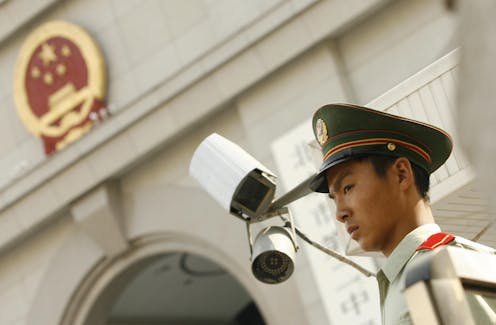China leans into using AI − even as the US leads in developing it
In the AI game, China has bet on strategic use over innovation, tightening its grip domestically and extending its reach internationally.

In the competitive arena of global technology, China’s ambitions in artificial intelligence stand out – not just for their scale but for their distinct strategic approach.
In 2017, the Chinese Communist Party declared its intent to surpass the United States to become the world leader in AI by 2030. This plan, however, is less about pioneering novel technologies and more about strategically adapting existing ones to serve state economic, political and social objectives.
While both China and the United States are actively pursuing AI technologies, their approaches differ significantly. The U.S. has traditionally led in fundamental AI research and innovation, with institutions such as Massachusetts Institute of Technology and Stanford and tech giants such as Google and Microsoft driving breakthroughs in machine learning. This innovation-first approach contrasts with China’s focus on adaptation and application of existing technologies for specific state objectives.
The United States’ AI development is primarily driven by a decentralized network of academic institutions, private companies and government agencies, often with competing interests and a focus on commercial applications. In contrast, China’s AI strategy is more centralized and state directed, with a clear focus on supporting government initiatives such as social control and economic planning.
AI for ideological control
At the heart of China’s AI strategy lies its effort to embed the technology in the machinery of the government’s ideological control. A prime example is the Xue Xi chatbot developed by researchers at China’s top-ranked university, Tsinghua University. Unlike Western AI models designed to foster open-ended dialogue, Xue Xi was trained in part on “Xi Jinping Thought” to indoctrinate users – likely initially to be party members in government – with Communist Party ideology.
This isn’t just a singular initiative but part of a broader trend. AI-driven surveillance systems, like the facial recognition technology deployed across the Xinjiang region of China, enable the government to maintain tight control over the area’s minority Muslim Uyghur population.
These technologies are not groundbreaking. They build on existing innovations but are finely tuned to serve the Communist Party’s efforts to maintain social order and prevent dissent. China’s AI prowess comes not by creating the newest technology but by mastering and deploying AI in ways that align with its ideological imperatives.
AI for economic control
China’s AI strategy is also deeply intertwined with its economic ambitions. Faced with slowing growth, the Communist Party views technology as the essential tool for pulling the country out of its economic slowdown. This is particularly evident in sectors such as manufacturing and logistics, where AI is used to drive efficiencies and maintain China’s competitive edge in global supply chains. For example, companies such as online retail giant Alibaba have developed AI-driven logistics platforms that optimize delivery routes and manage warehouse operations, ensuring that China remains the factory of the world.
Additionally, China’s social credit system, which rates citizens on their civic and financial behavior, represents a significant strategic initiative where AI plays an increasingly crucial role. China’s system is designed to monitor and influence citizen behavior on a massive scale. Although AI is not yet fully implemented across the entire social credit system, it is being integrated to track and analyze vast amounts of data, such as financial transactions, online interactions and social relationships in real time.
This data is then used to assign scores that can affect various aspects of life, from loan approvals to travel permissions. As AI becomes increasingly embedded in the system, it is likely, I believe, to further reinforce state control and ensure societal compliance, prioritizing government oversight over personal autonomy.
Strategic exports
On the international stage, China is exporting its AI technologies to expand its influence, particularly in developing nations. Through the Belt and Road Initiative, Chinese tech giants such as Huawei and ZTE are providing AI-driven surveillance systems to governments in Africa, Southeast Asia and Latin America. These systems, often framed as tools for improving public safety, are part of a larger strategy to export China’s governance model.
For instance, in Zimbabwe, Chinese firms have helped implement a nationwide facial recognition system under the guise of combating crime. Political activists in Zimbabwe fear that technology is being used to monitor political opponents and activists, mirroring its use in China. By exporting AI technologies that are tightly integrated with state control, China is not only expanding its market share but also promoting its authoritarian model as a viable alternative to Western democracy.
AI for strategic military advantage
China’s military ambitions are also tightly linked to its AI strategy. The People’s Liberation Army, China’s military, is investing heavily in AI-driven autonomous systems, including drones and robotic platforms. These technologies are not necessarily the most advanced in the world, but China is adapting them to fit its strategic needs.
China is developing AI systems to support its naval operations in the South China Sea, a region of significant geopolitical tension. China is deploying autonomous submarines and surveillance drones to monitor and potentially disrupt foreign military activities in the region. This strategic use of AI in military applications highlights China’s focus on using existing technologies to achieve specific geopolitical objectives, rather than seeking innovation for its own sake.
Calculated strategy
China’s approach to AI is a calculated strategy of adaptation and application, rather than raw innovation. By mastering the use of existing technologies and aligning them with state objectives, China is not only bolstering its domestic control but also reshaping global power dynamics.
Whether through ideological indoctrination, economic control, strategic exports or military advancements, China’s AI playbook is a powerful reminder that in the realm of technology, how tools are used can be just as transformative as the tools themselves.
Shaoyu Yuan does not work for, consult, own shares in or receive funding from any company or organization that would benefit from this article, and has disclosed no relevant affiliations beyond their academic appointment.
Read These Next
The #iwasfifteen hashtag and ongoing Epstein coverage show how traffickers exploit the vulnerabiliti
The conversation around #iwasfifteen sheds light on the dynamics of abusive relationships and the experiences…
From record warming to rusting rivers, 2025 Arctic Report Card shows a region transforming faster th
The 20th anniversary of the annual report tracks how sea ice, snow cover and many other vital signs…
2 superpowers, 1 playbook: Why Chinese and US bureaucrats think and act alike
The men and women tasked with implementing policy are governed by the same incentives and constraints…






